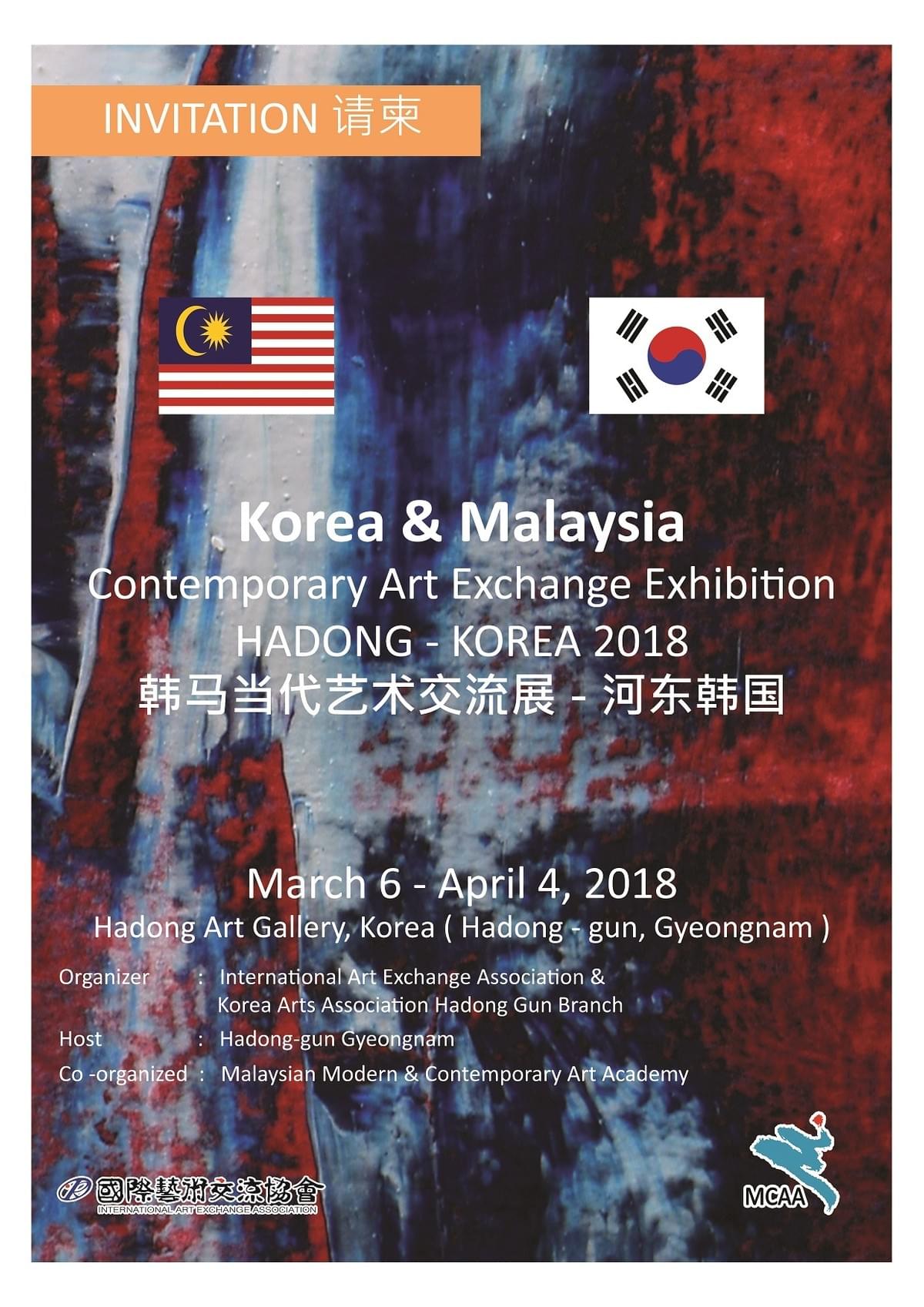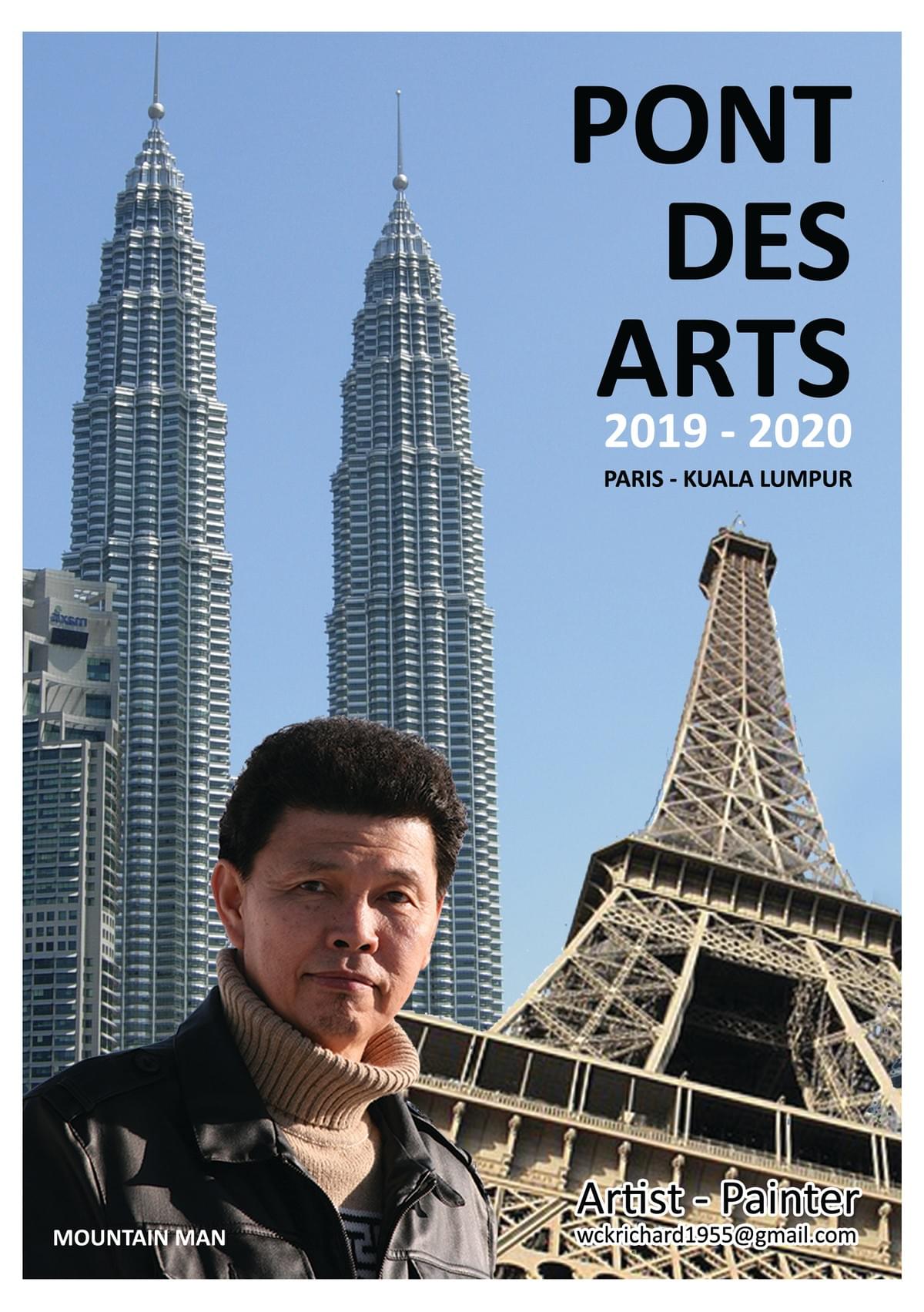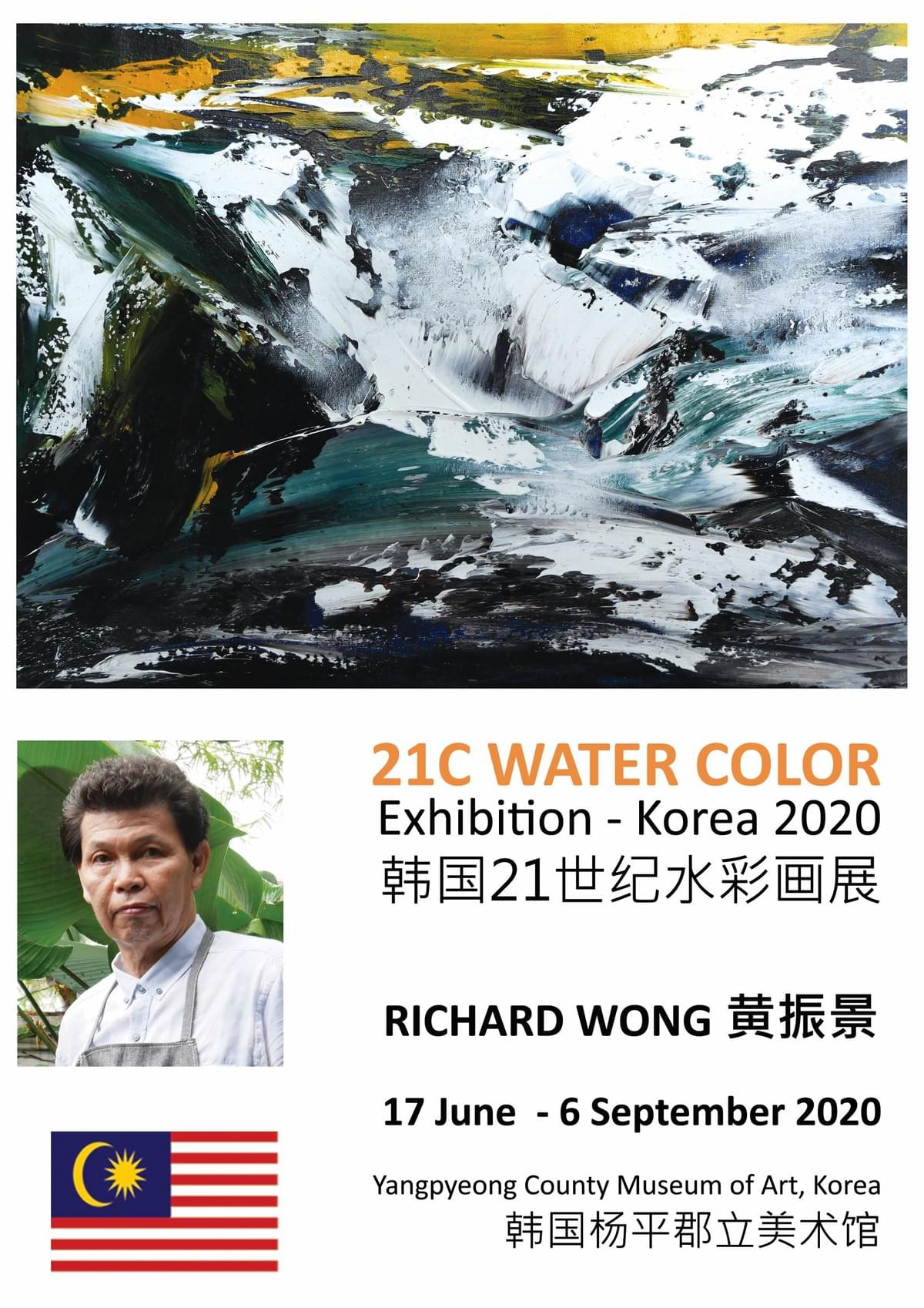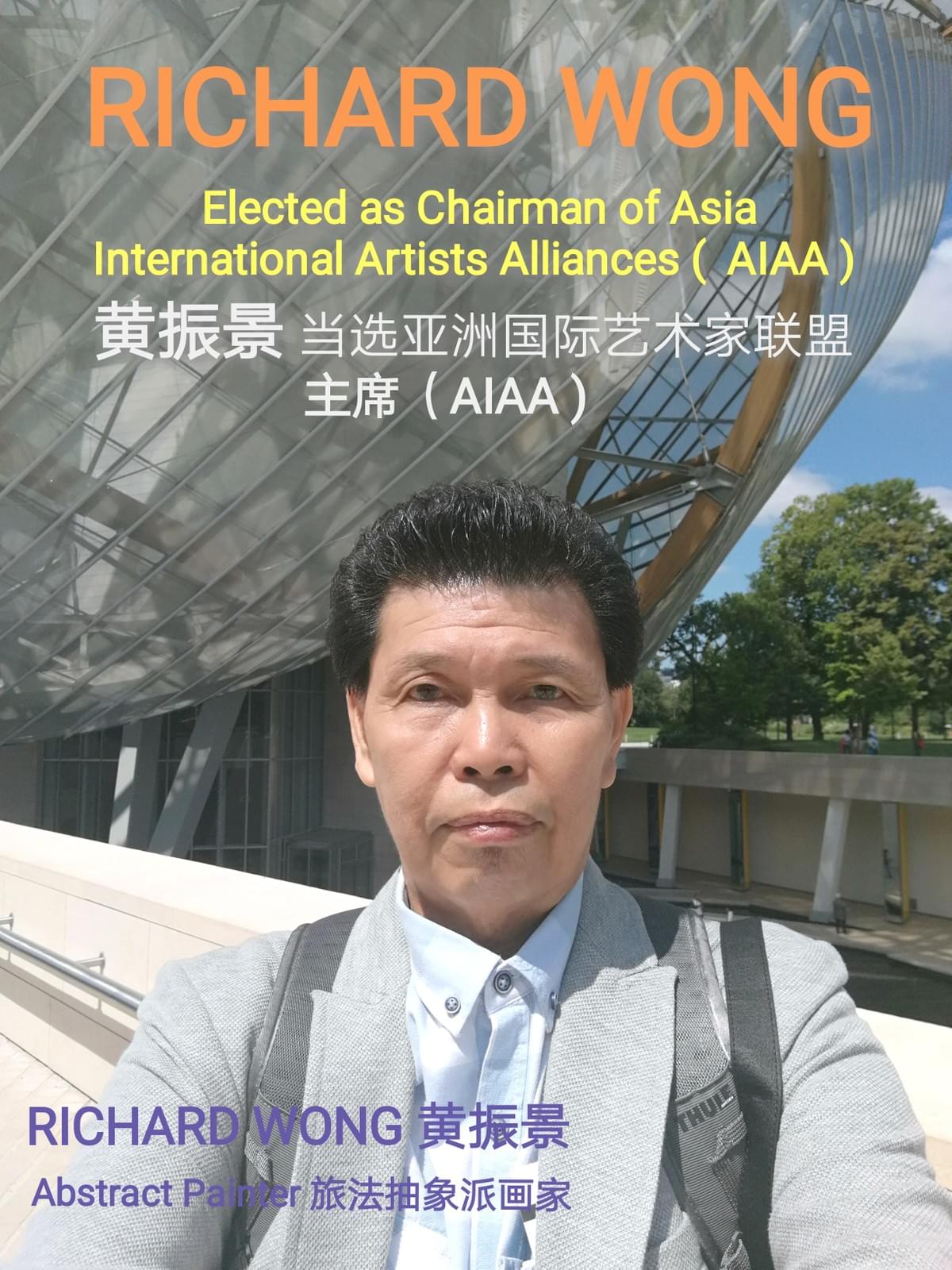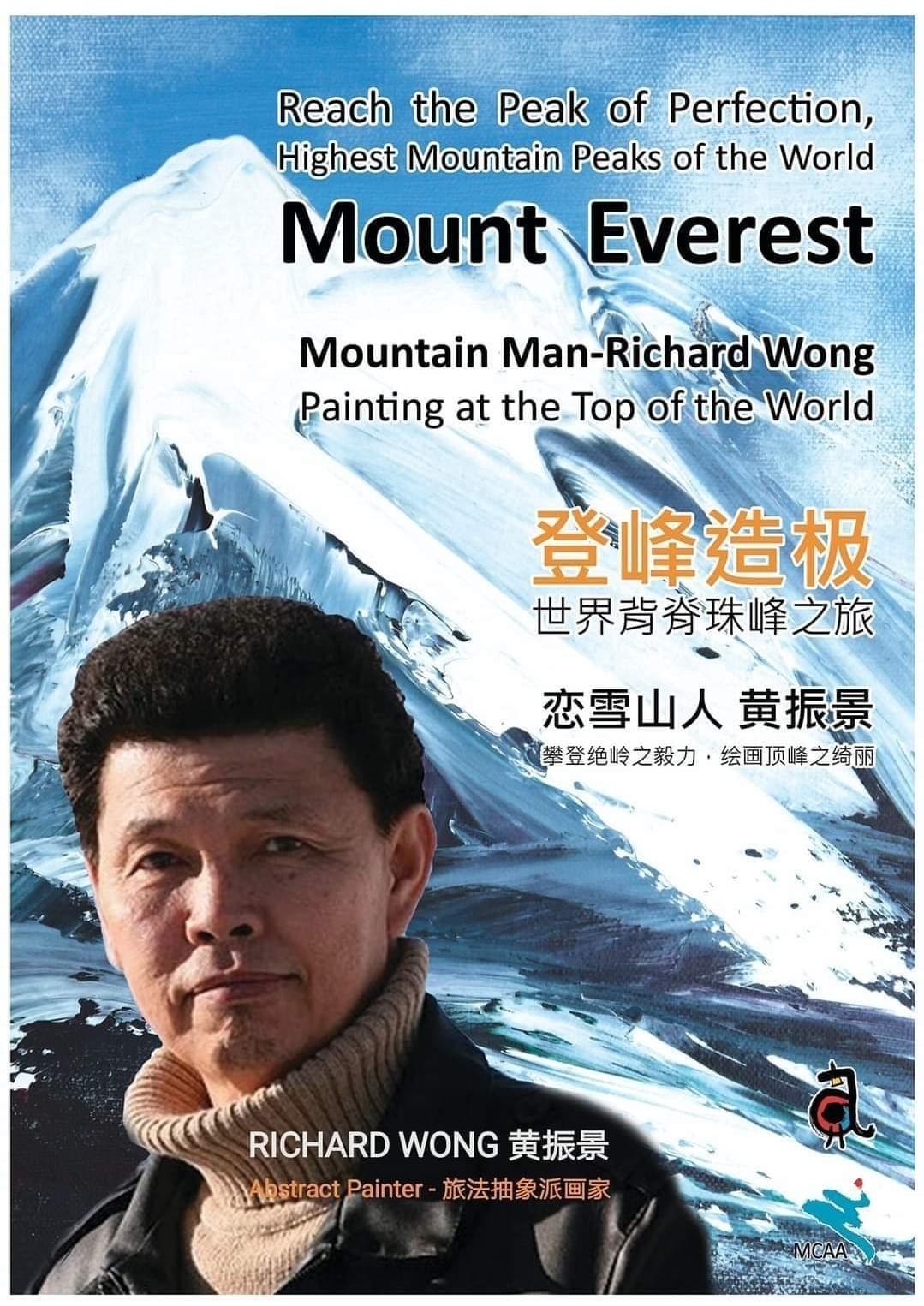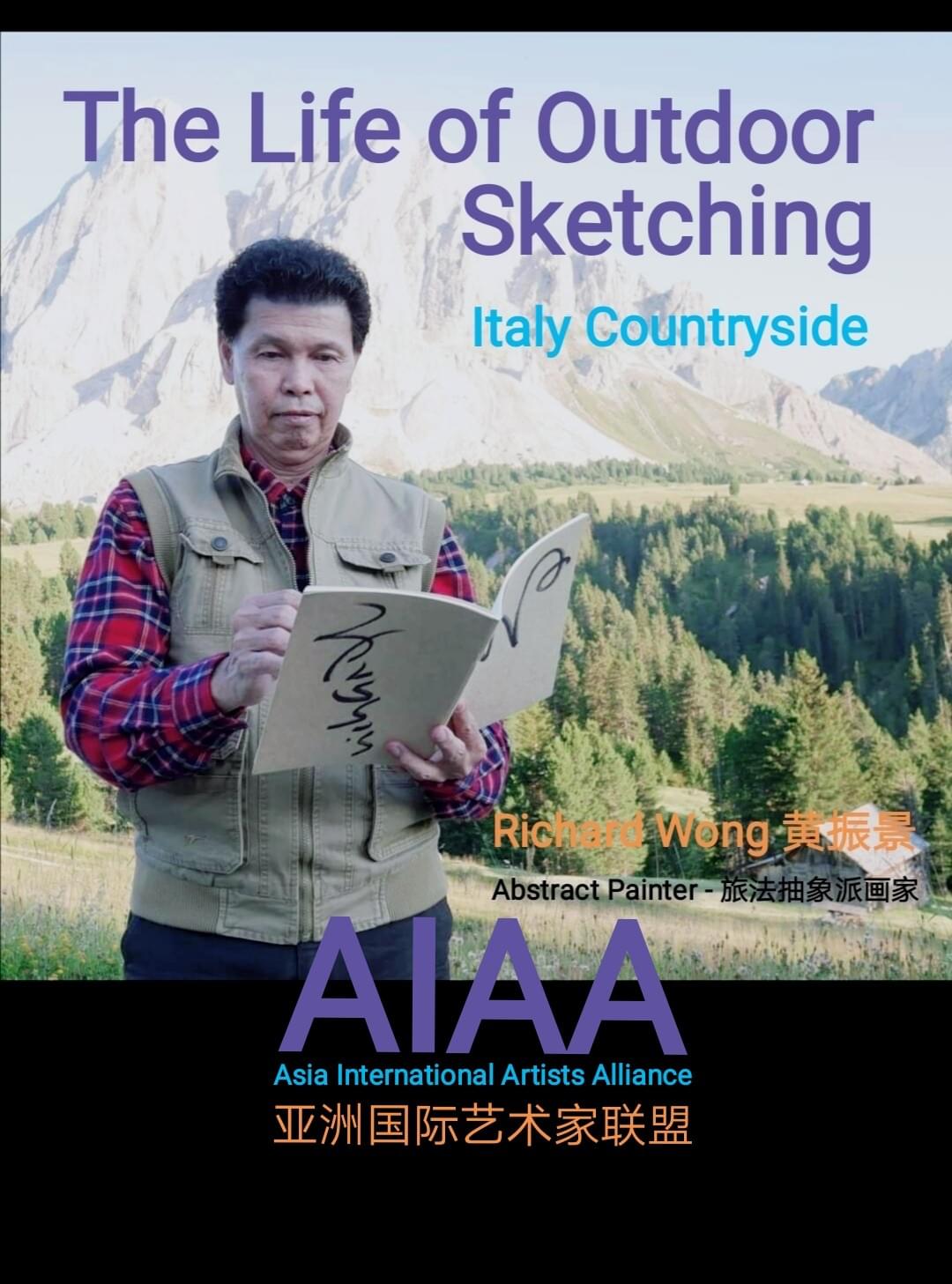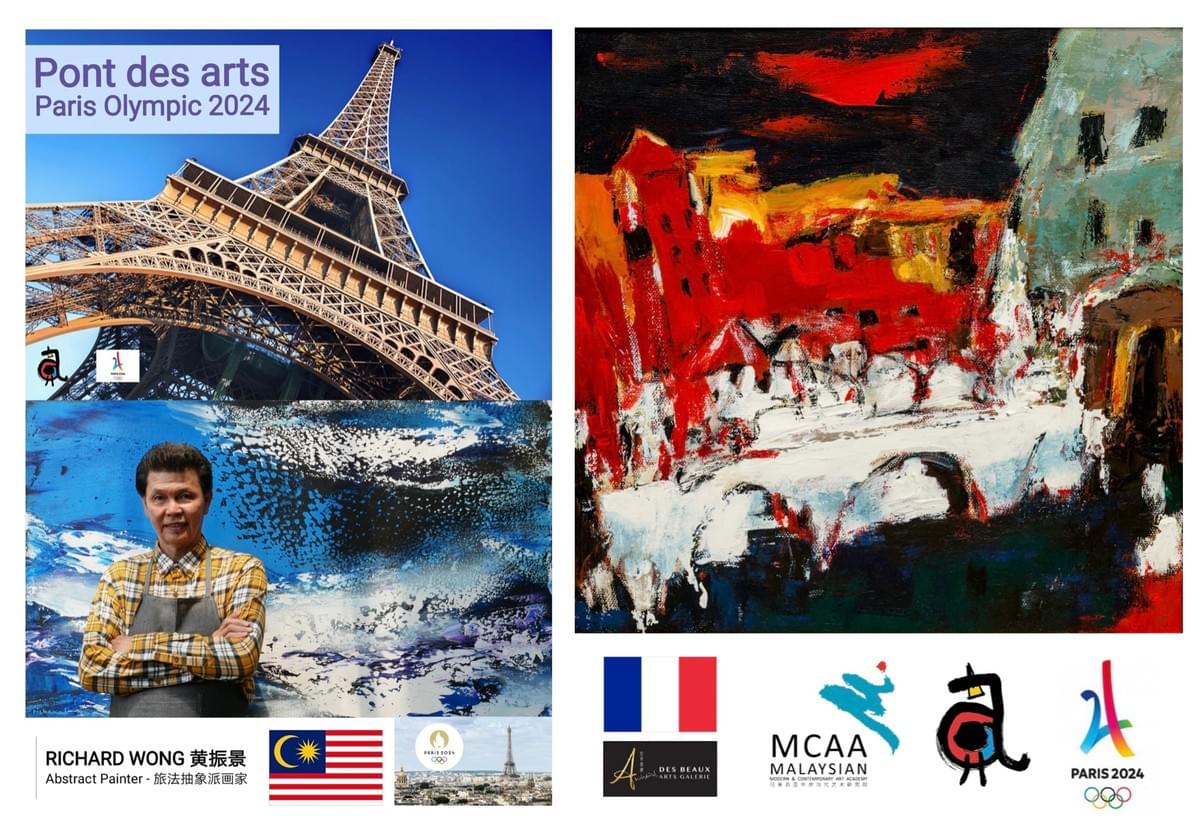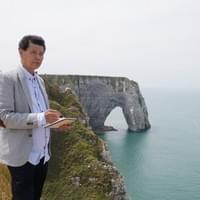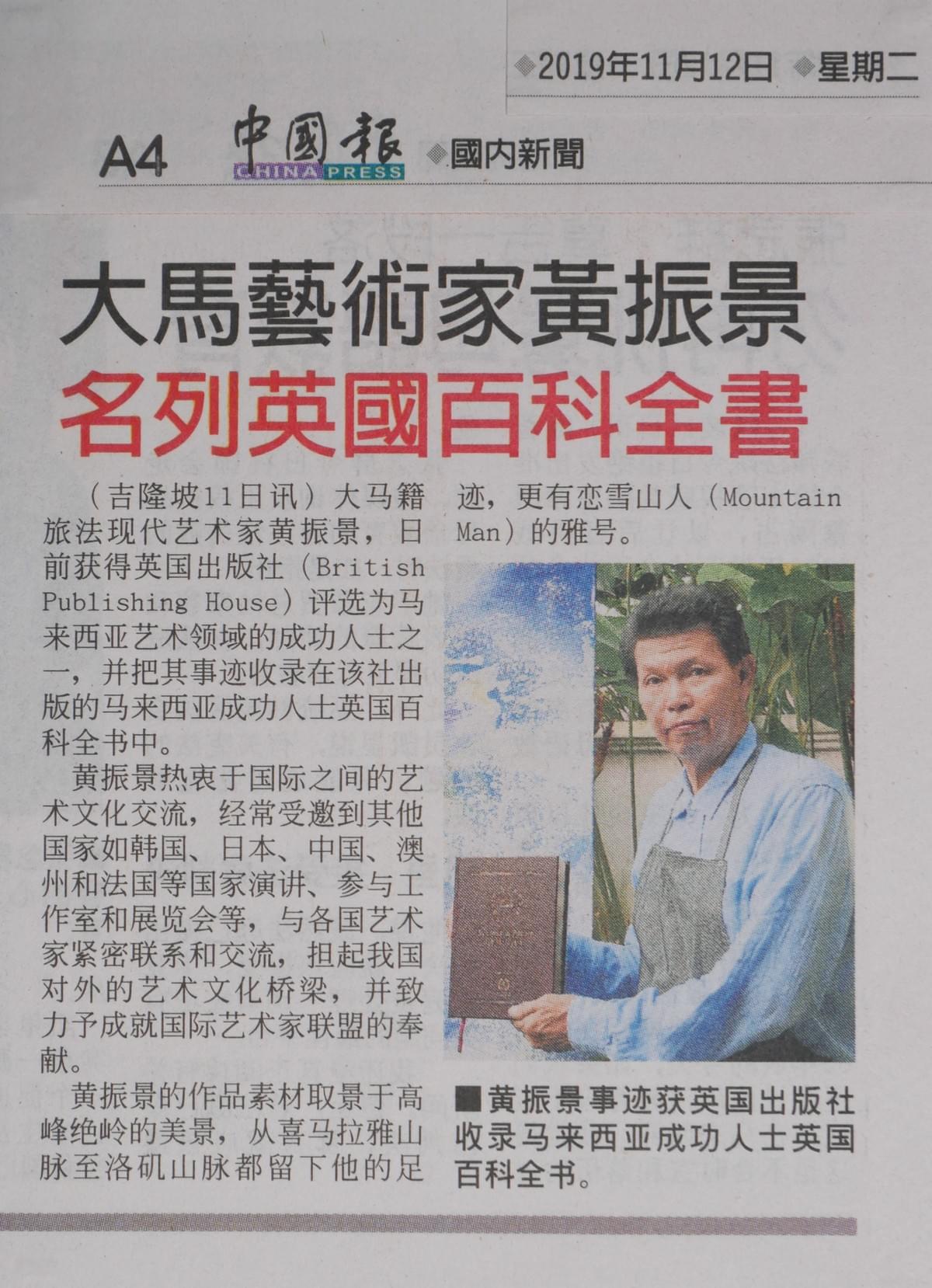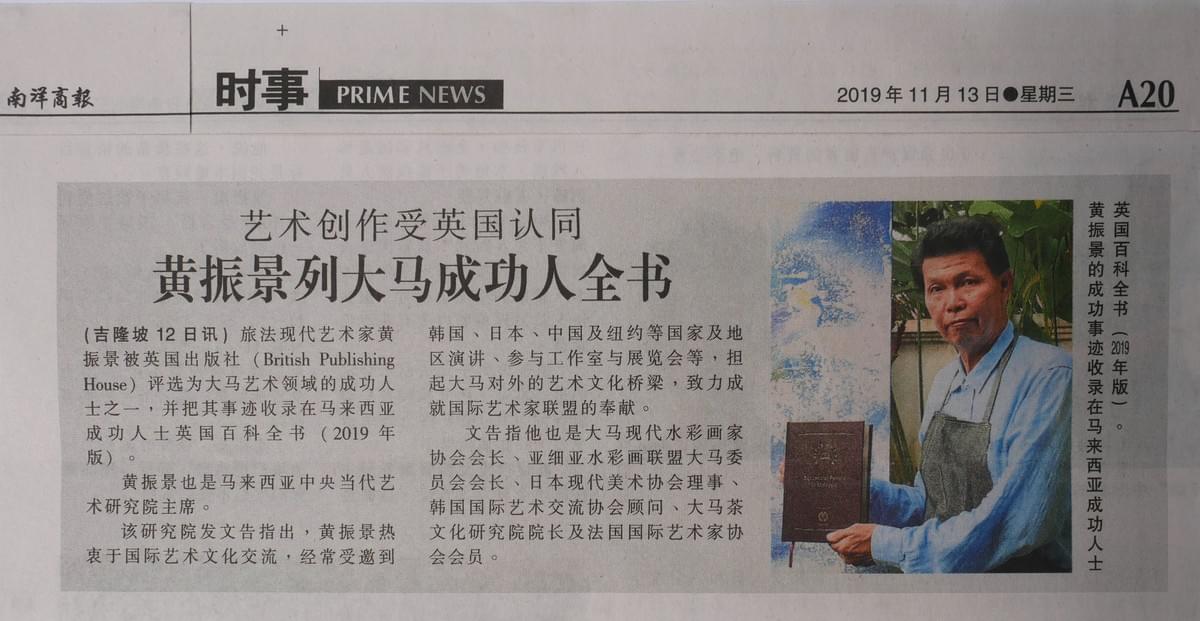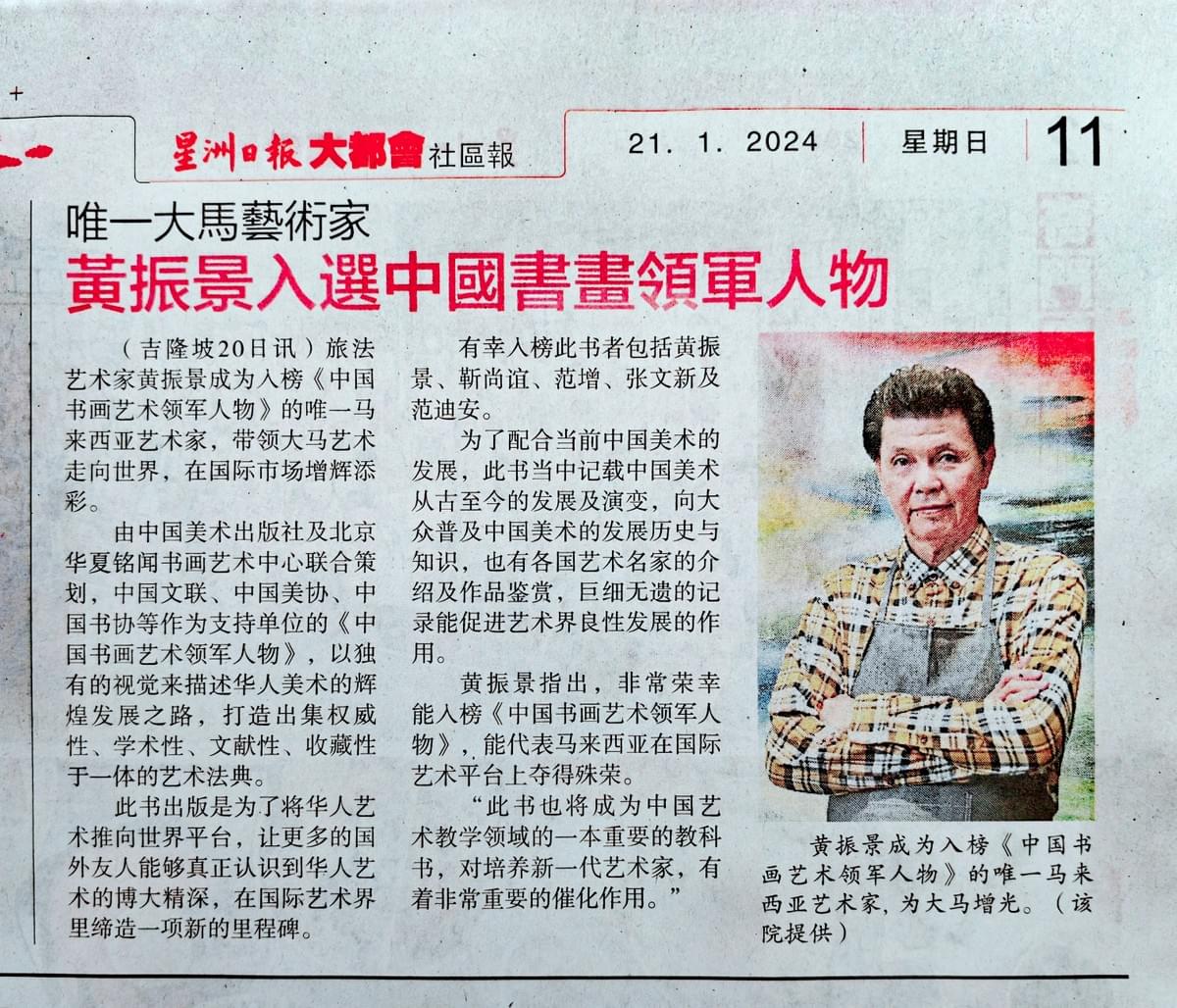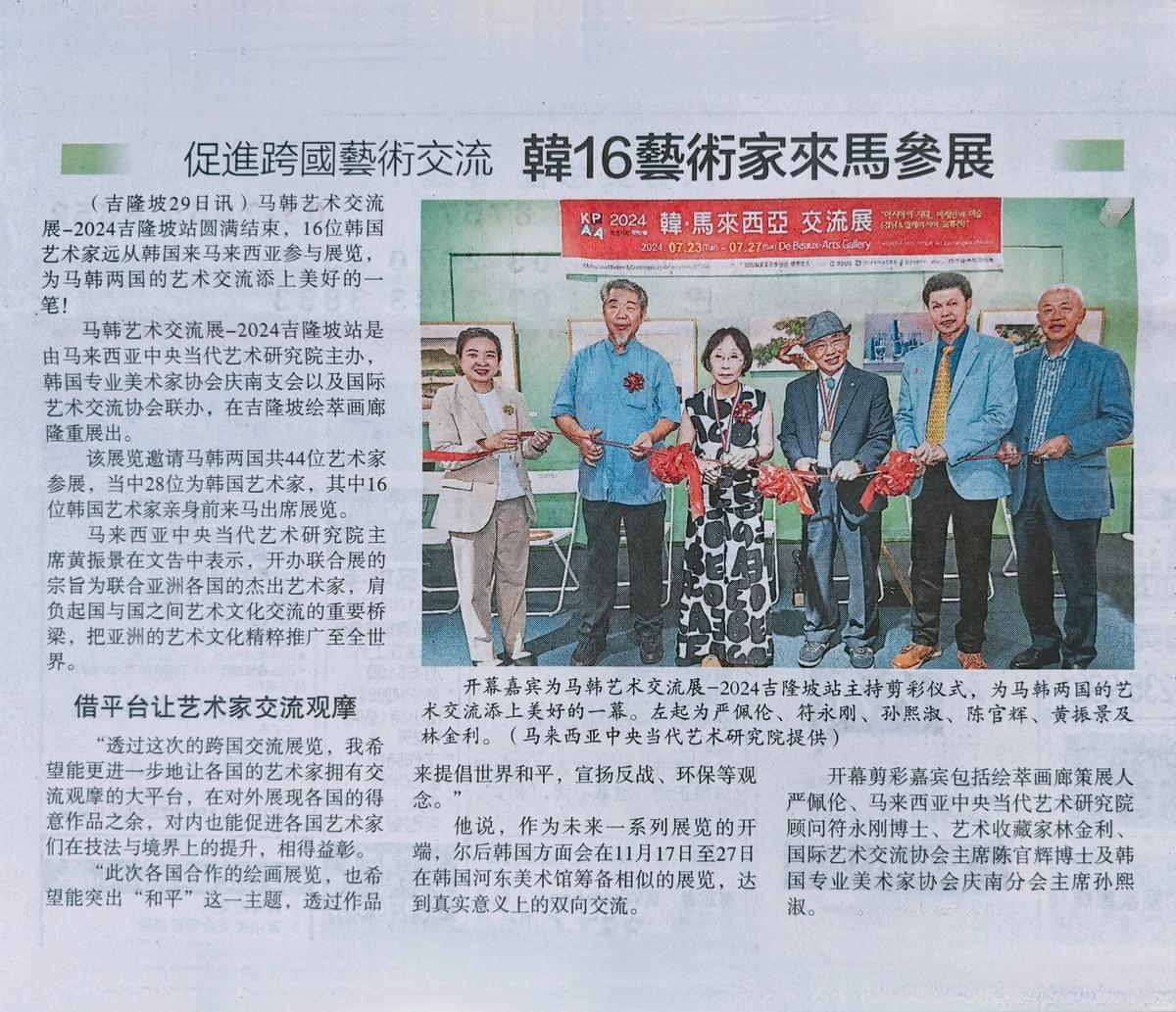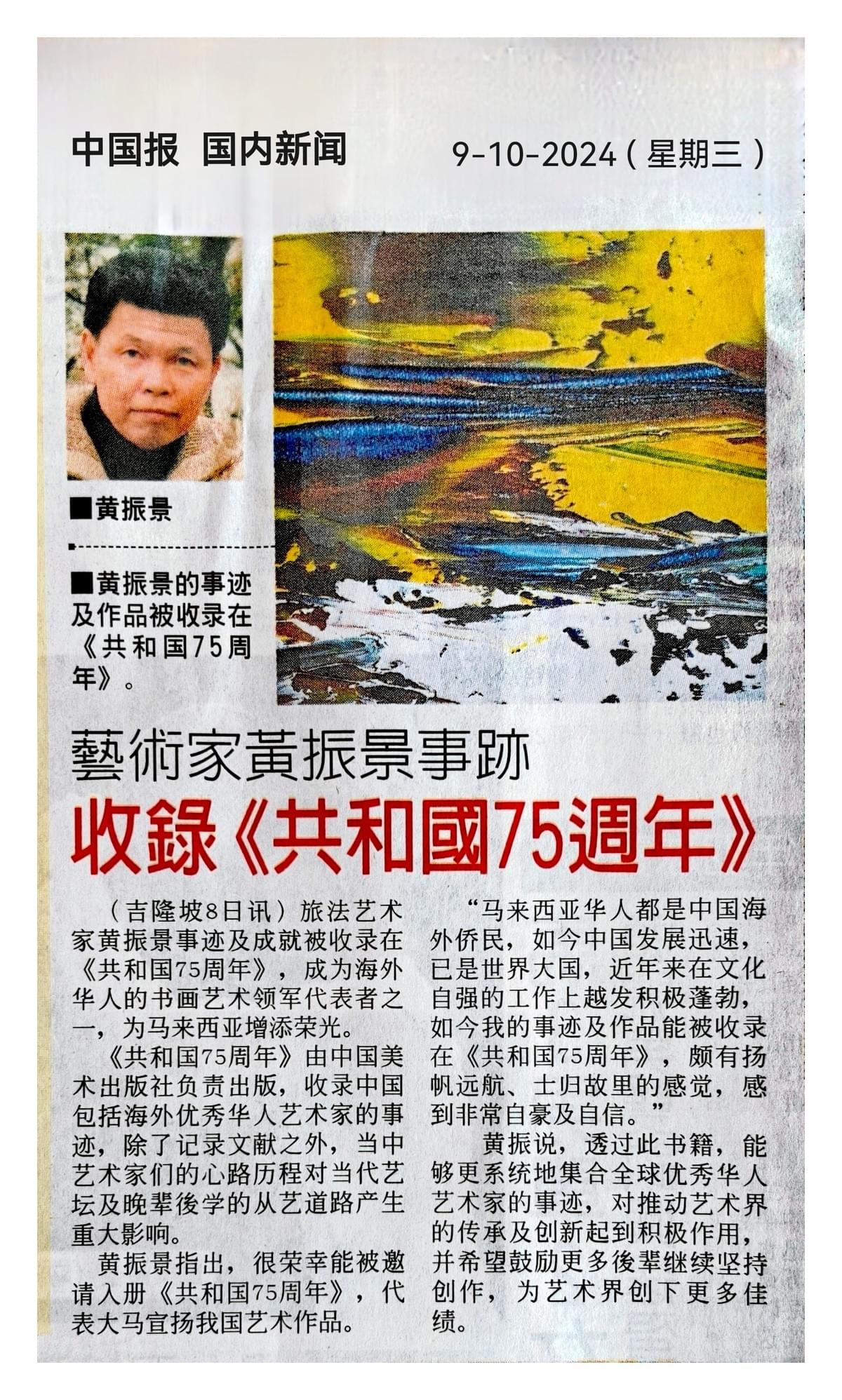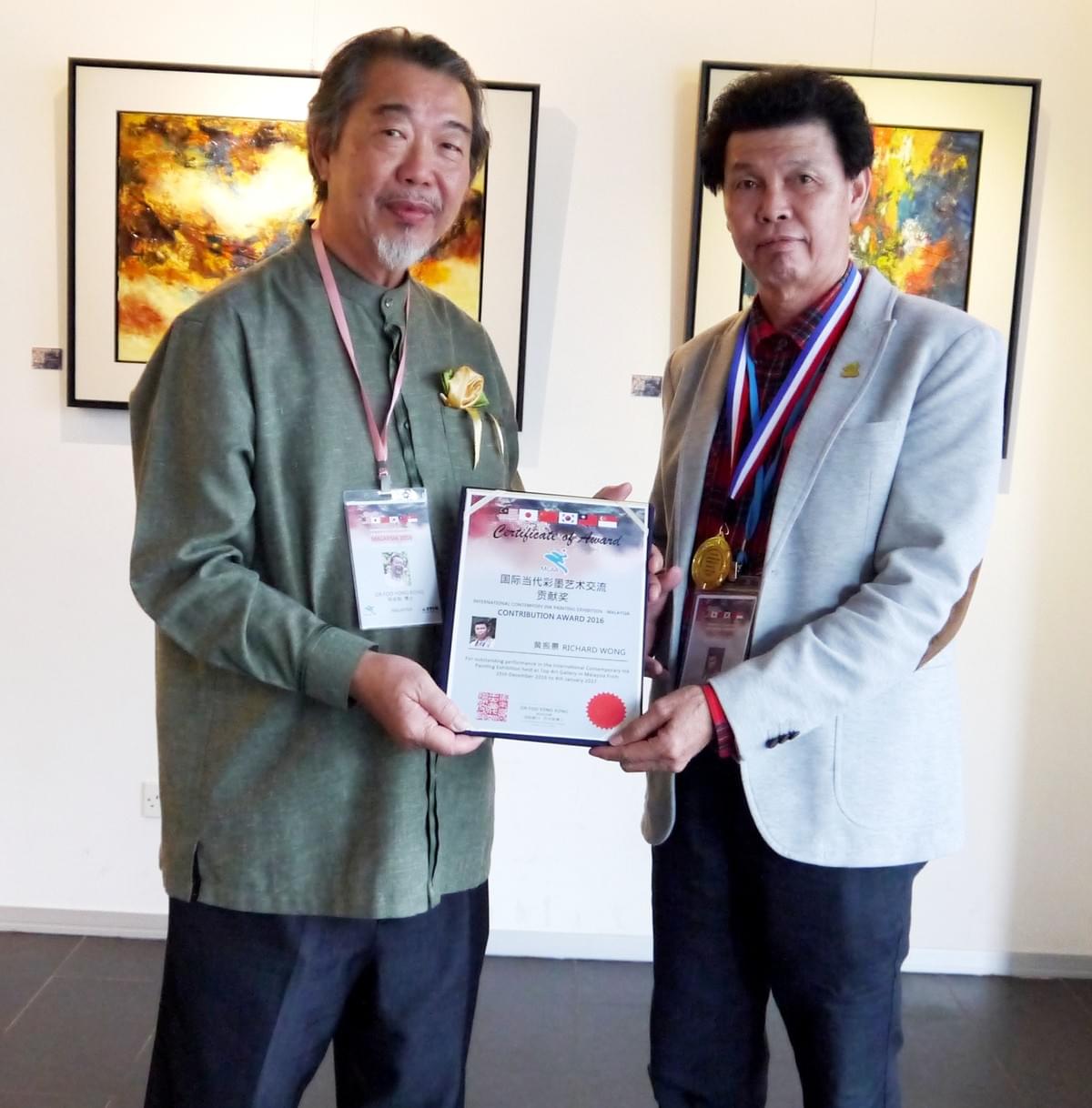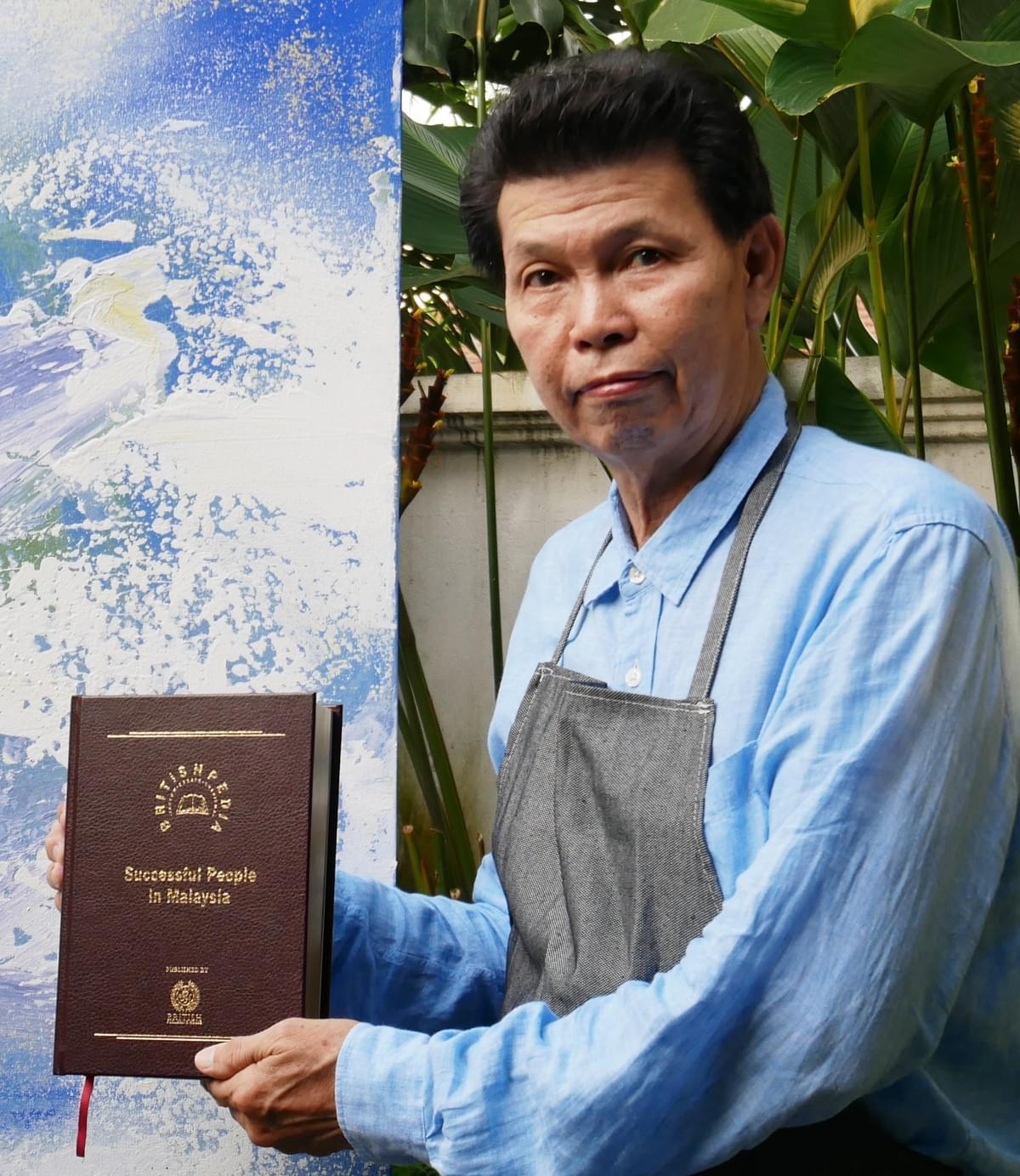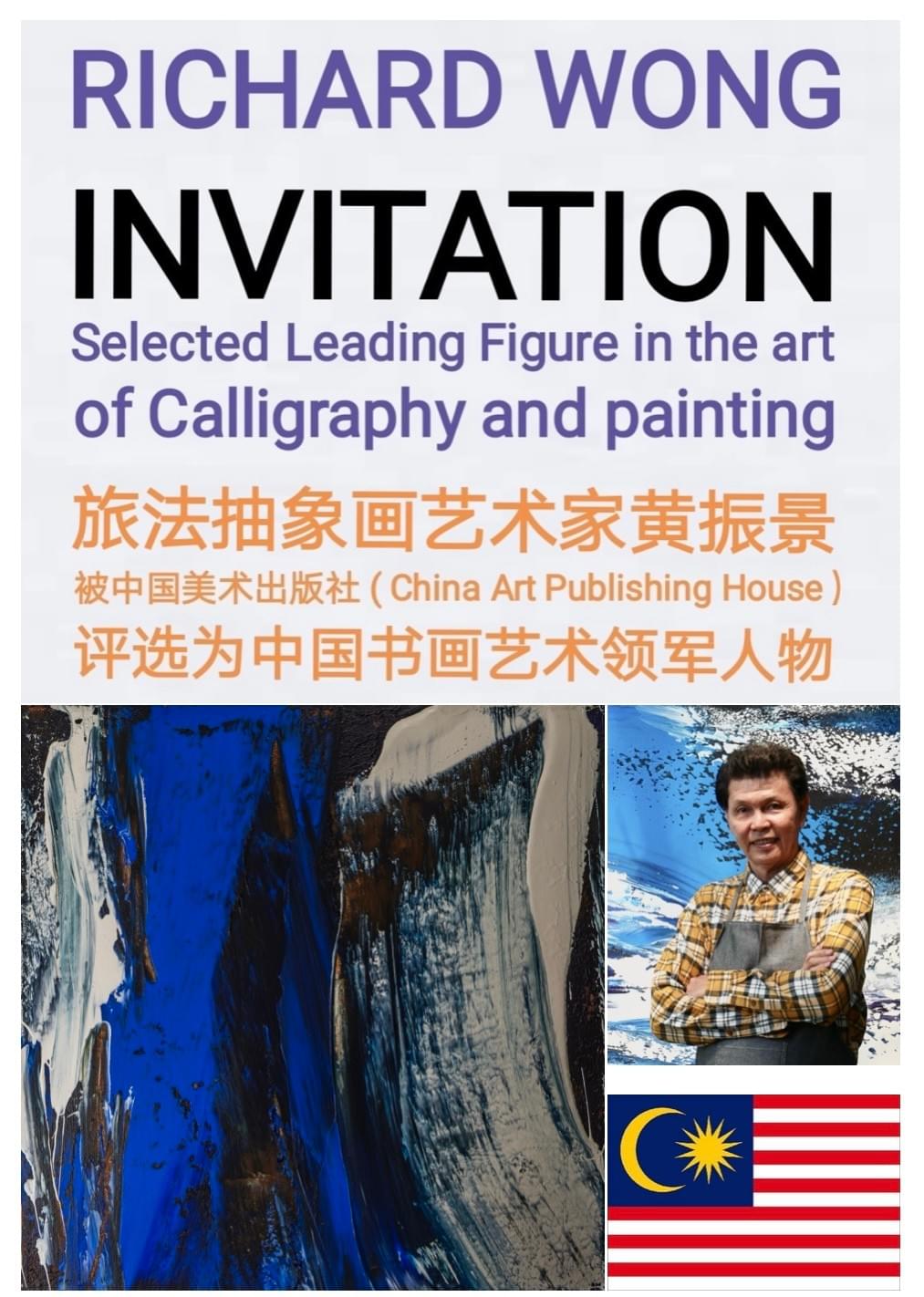
Richard Wong - Mountain Man
黄振景 - 恋雪山人
Abstract painter, traveler, collector.
Internationally renowned contemporary abstract painter Richard Wong was born in Kuala Lumpur, Malaysia in the year 1955. He pursued Western Art at the Kuala Lumpur College of Arts, Malaysia Fine Arts Department from 1975 to 1978. Between the years 2000 to 2001, he spent time at the Internationale Cite des Arts, Paris (ICDA) to study oil paintings, devoting his time mainly to French modern art. He is at present an abstract painter.
Richard Wong is currently Chairman of Asia International Artists Alliance (AIAA), Chairman of Malaysian Modern & Contemporary Art Academy (MCAA), President of Contemporary Malaysian Watercolorists Association (CMWA), Advisor of Korea International Art Exchange Association, President of Malaysian Tea Art Culture Academy, Founder of Ying Wudao and ShaoLin Martial Art Academy Kuala Lumpur, President of Malaysia Division of World Calligrapher - Painter Organization of Canada, committee member of Japan Modern Fine Arts Association (JMFAA), Chairman of Asia Watercolour Painting Alliance (AWPA), member of International Association of Art, (IAA AIAP UNESCO, PARIS) since 1986 and member of World Watercolor Association, Korea.
享誉国际当代抽象派画家黄振景, 出生于1955年马来西亚吉隆坡, 1978毕业于马来西亚吉隆坡 美术学院西洋画科系。 2000 - 2001 巴黎国际艺术城工作室进修油画并潜心钻研法国现代艺术, 现为抽象派画家。
黄振景现任亚洲国际艺术家联盟主席, 马来西亚中央当代艺术研究院主席, 马来西亚现代水彩画家协会会長, 韩国国际艺术交流协会顾问, 马来西亚茶文化硏究院院长, 膺武道暨吉隆坡少林武术舘创始人, 世界书画家协会马来西亚分会会长, 日本现代美术协会理事, 亚细亚水彩画联盟主席, 韩国世界水彩画联盟协会会员及法国国际艺术家协会会员(IAA AIAP UNESCO,PARIS) - 1986。
Abstract
Posters































































Food & Drink





Travel
Catalogue




Articles

Abstraction
Richard Wong Chin-Kim is a Malaysian artist who indulges in memories and mindscapes.He is an artist drawing on the artist within and drawing on the right side of the brain. His approach in art is that of the right-mode --- intuitive, spatial, onoverbal, simultaneous and perceptual.
In his abstracted mindscapes based on submerged memories of places seen, noted and processed, the sub-conscious is permitted to roam. The artist is a much-travelled person, roaming Planet Earth in search of art and collectibles, tea and sympathy and Shaolin martial art and health-cum-longevity. As an individual, he is interested and interesting, keen to share his multifanous interests, which ranged from watercolour-painting to Chinese tea-ceremony, with others.
Lingering memos and memories of China, Nepal, India, Australia and so forth provided the impetus to launch his series of dreamy, lyrical mindscapes.
In his classic, The Meaning of Art, the late great Sir Herbert Read posited: "We must not be afraid of this word 'abstract'. All art is primarily abstract."
In his elucidating tone, understanding Abstract Art, Frank Whiford opines: Whether the word abstract or a synonym is used, a definition remains difficult, perhaps impossible to achieve. Just as all art is primarily abstract, all abstract art is, in a sense, representational. Some abstract paintings intentionally allude to aspects of the familiar world; others unintentionally evoke them! It is difficult to invent an image which will not remind viewer of something. The urge to see a face in every circle is irresistible. Even a perfect horizontal line bisecting a rectangle will look like a landscape."
Leonardo da Vinci, in his Notebooks, noted: "It should not be hard for you to stop sometimes and look into the stains of walls, or ashes of a fire or clouds or mud or like places in which you may find really marvellous ideas."
In Richard Wong's abstraction, the landscape is the basis of his theme. The mindscapes are derived from the various components of the lands and forms of the sky, land and sea punctuated with mists, rocks and erosions which served to enrich the textural images. The mindscapes represent his cryptomnesia or concealed recollection burst forth in terms of glows, flows, cracks, stains, veils, dribbles, dots and splashes resulting in positive and negative textural effects that recalled the Abstract Expressionist renditions of Jackson Pollock, Mark Rothko, Morris Louis, Helen Frankenthaler and Sam Francis in variations. In his visual essays, there is the rhythmic beat of the forces of nature that spells poetry.
Employing oil and acrylics on canvas and equipped with brushes, pallete knives for various textural effects, Richard Wong concocted a variety of images that, seen in the light of da Vince's slant, are a notion of poetry in motion. Altogether the marks and stains challenge one of a variety of reading of places evocative and poetic.
Frank Whiford reminds us: "Abstract art approached with an open mind can suggest entirely new ways of seeing. Knowledge, of the painter's ideas and intentions, experience, gained from looking at pictures, and open-mindedness: these represent the viewers' contribution, the key to forming judgments and enjoying abstract art."
Back in 1890, Maurice Denis noted perceptively: "It must be remembered that any painting - before being a war horse, a nude woman, or some anecdote - is essentially a flat surface covered with colours and arranged in a certain order."
In conclusion, kindly allow me to share with you a thought from the poet Percy Bysshe Shelly:
The mind in creation is as a fading coal which some invisible influence, like an inconstant mind, awakens to transitory brightness; this arises from within....and the conscious portions of our nature are unprophetic either of its approach or of its departure."Verily, truly. food for meditation.
Teng Chok-Dee
Lecturer-Curator
LaSalle-SIA,
a college of the arts,
Singapore
WHITE PARADISE - a sequel to "In Search of Shangri-La".
In his personal sojourn to seek for perfection and nature's pristine and untouched beauty - a journey akin to James Hilton's quest for Shangri-La, the lost paradise on earth, Richard Wong's journey has now taken him to the surreal world of steep mountains and deep valleys with its heart-stopping visage of sheer vertical cliffs and deep plunging valleys and cascading waterfalls found only in this remote southwestern corner of China. In the province of Sichuan - China's largest province bordering the province of Yunnan to the south and Tibet to the west, near the upper reaches of the Yangtze River, the region known as China's Hidden Heart and which is home to many of China's ethnic minorities.
From April to June 1998, Richard Wong had started his sojourn from Chengdu, home of the great Tang poet Du Fu (712-770) and the capital of Sichuan Province. From there, he slowly made his way through the quaint remote villages situated at the foothills of the Qionglai Mount Range on the Alba Plateau. Using the local means of transport, the old and rickety trucks salvaged from old army trucks left behind by the Allied forces during WWII when Kunming was the most important transit stage of the old China - Burma Road, he traversed along the long and winding mountain roads towards Yunnan Province in South West China passing through the old Southern Silk Road, to see for himself the "Lost Paradise" before it is "discovered" and spoilt by the hordes of tourist that would soon swamp this remote corner of the world.
Broke and feeling a little homesick by now, Richard Wong had to break journey but he vowed to return to continue his personal quest for his Shangri-La.
Captivated and enchanted by what he saw, Richard Wong soon felt restless and was eager to continue his sojourn. So in October 1998, he flew to Chengdu once again, to take the high road - but this time northwards for he had set his eyes on Kunlun Mountain. (Kunlun Range) venerated throughout China as the birthplace of China's two great rivers, the Yellow River to the north and the mighty Yangtze River to the south.
Then from Lhasa in Xizang (Tibet), he traversed westwards towards the Karakorum Shan in South West Xinjian Autonomous Region and hence to his destination of Qogir Shan (Mount Qogir). There, he trekked the land of jagged mountain peaks and spare mountain hamlets nestled in between deep clear lakes which turned into shimmering glaciers of sheer white ice with all shades of white in winter from zinc white to grey white - which provides a sharp contrast to clear blue skies and the changing golden hues of the leaves of autumn. He continued his journey to Nepal where he made his last stop at the base camp of Mount Everest.
Entranced and captivated by what he saw, Richard Wong has tried to transpose onto canvas, the vivid and austere of what he calls "White Paradise" - a mindscape so alien to the lush tropical colours of his native land of Malaysia. Here, as far as the eyes could see were the far pavilions of sheer gleaming glacial tops glistening in the sun in the distant mountains. All these, the eyes of Richard Wong have seen - these visages of magic that he calls his "White Paradise" - not far from his paradise on earth, his Shangri-La.
C. K. Tan
a collector,
Calgary, Alberta.




“A BEAUTIFUL JOURNEY”
at Top Art Gallery
by RICHARD WONG.
Richard Wong’s inspirations are largely derived from nature’s pristine and wondrous beauty which had enthralled him in his travels throughout the countries of the Pacific rims and many other Asia countries including Yunnan, Tibet, Nepal and Silk Road – China.
The call of the mountains, this time the lure of the Rockies of Canada, has proved too irresistible for Richard Wong, the intrepid Mountain Man, to ignore. Having trekked the lonely and desolate mountain ranges of the Himalayas and the Kunlun Shan located in Sichuan, Province of South West China in the late 1990’s Richard Wong is off again, this time westwards to the Rockies of Alberta, Canada. Along the way, he will no doubt make a detour to the Okotoks and Lake Louise with its sheer and transparent water, glistening in the sun like diamonds and the mirror image of the surrounding mountains transposed on its calm waters.
And now the admirers of Richard Wong’s artistry and creation will no doubt forget the hectic hustle and bustle of life to pause, reflect and admire the true wonder and glory of one of nature's greatest creation, the Rockies of Canada.
The exhibition will be held from the 11th June till 25th June 2012
Venue: TOP ART GALLERY,
20-22, Jalan Bayu Tinggi 6, Taman Bayu Tinggi, 41200 Klang, Selangor D.E.
E-mail: zhenjing55@hotmail.com
Opening daily from 11.00 A.M. to 6.00 P.M.Admission is Free


















































Art Exchange
Societies

Appointment Letter as Advisor to Kaouhsiung Art Association
Appointment of the President of Contemporary Malaysian Watercolorists Association (CMWA), Mr. Richard Wong as Advisor to Kaouhsiung Art Association, Taiwan.
Seen above is Ms. Christin Wu, Director of Kaouhsiung Art Association Taiwan presenting Mr. Richard Wong with the certificate formalising his appointment in 2016.

Contribution Award - International Contemporary Ink Painting Exhibition Malaysia 2016
Dr. Foo Yong Kong, Advisor of Malaysian Modern & Contemporary Art Academy (MCAA) presenting Mr. Richard Wong with the contribution award for the International Contemporary Ink Painting Exhibition Malaysia 2016.

Winner of 2017 Highest Honour Foreign Minister's Award at the 36th NICHIGENTEN Art Exhibition, Osaka City Museum of Arts in Japan.
Mr. Seiji Kitatobe , President of Japan Modern Fine Arts Association (JMFAA) presenting Mr. Richard Wong with the Highest Honour Foreign Minister's Award for the 36th NICHIGENTEN Art Exhibition, Osaka City Museum of Arts, Japan.



Britishpedia: Successful People in Malaysia, 2019
Art creation recognized by the United Kingdom.
Richard Wong listed as a successful person in Malaysia.
Britishpedia: Successful People in Malaysia, 2019
Art creation recognized by the United Kingdom.
Richard Wong listed as a successful person in Malaysia.
Pont des Arts Exhibition - Paris & Kuala Lumpur 2019-2020

Awarded the highest honorary "President's Award" - 2022 by the Federation of Artistic & Cultural Organization of Korea.

Awarded the highest honorary "President's Award" - 2022 by the Federation of Artistic & Cultural Organization of Korea.



Richard Wong - Mountain Man
Overseas Exhibition of Outstanding Chinese Artists Broadcasted in Time Square, New York
21st July 2023, 20:30pm.

Selected Leading Figure in the Art of Caligraphy and Painting - China Art Publishing House

Recommended for Permanent Council Member of the Japan Modern Art Association in 2023.

Contribution Award - International Abstract Art Award 2022
Dr. Foo Yong Kong, Advisor of Malaysian Modern & Contemporary Art Acadamy (MCAA) presenting Master Richard Wong with the Contribution Award for conducting the Malaysia & Korea Art Exhibition Malaysia 2022.
旅法抽象画艺术家黄振景在马韩艺术大展 - 吉隆坡 2022 的展览会上获得由马来西亚中央当代艺术研究院
颁发国际抽象艺术贡献奖。

Winner of 2024 Asia Culture Contribution Award at the International Contemporary Art Exchange Exhibition in Hadong Culture Art Center, Korea.
Dr. Chin Kwan Hwi, President of International Art Exchange Association (IWAW) presenting Master Richard Wong with the Asia Culture Contribution Award at the International Contemporary Art Exchange Exhibition in Hadong Culture Art Center, Korea.
旅法抽象画艺术家黄振景获得韩国国际艺术交流协会 ( IAEA ) 颁发最高荣誉 " 2024年亚洲文化贡献奖 "

Richard Wong elected as Chairman of Asia Watercolour Paintaing Alliance (AWPA) by Mr. Seiji Kitatobe.
Mr. Seiji Kitatobe presenting the Certificate of Appointment to Richard Wong as the next Chairman of Asia Watercolour Painting Alliance (AWPA) from 2025 to 2028.
Profile

Richard Wong's Profile
Born in 1955, June 01, Kuala Lumpur, Malaysia.
ART EDUCATION
1975 – 1978 - Kuala Lumpur College of Art (KLCA).
2000 – 2001 - Internationale Cite des Arts, Paris (ICDA).
ART SOCIETIES
1978 - Founder of ShaoLin Martial Art Academy Kuala Lumpur.
1982 - President of Malaysia Tea Art Culture Academy.
1983 – 2002 - Member of Malaysian Artists’ Association.
1983 – 1991 - Founder Member and Committee Member of Malaysia Watercolour Society (MWS).
1986 - Member of International Association of Art, (IAA AIAP UNESCO, PARIS).
1990 - Founder of WCK Galleries, Kuala Lumpur.
1992 - Founder Member of Contemporary Malaysian Watercolourists Association (CMWA).
1994 - Member of Asia Watercolour Painting Alliance (AWPA).
1998 – 2004 - Vice President of Contemporary Malaysian Watercolourists Association (CMWA).
2002 - President, Malaysia Division of World Calligrapher-Painter Organization,Canada.
2003 - Founder and Chairman of Malaysian Modern & Contemporary Art Academy (MCAA).
2003 - Curator of Malaysian International Contemporary Chinese Paintingand Calligraphy Association.
2005 - Member of World Watercolor Painting Federation (WWPF).
2008 - Committee Member & Judge of Japan Modern Fine Arts Association (JMFAA).
2012 - Curator & Vice President, Malaysia Division of Asian Watercolour Painting Alliance (AWPA).
2013 - President of Contemporary Malaysian Watercolourists Association (CMWA).
2014 - General Council Member of Malaysian Modern & Contemporary Art Academy.
2017 - Advisor of Korea International Art Exchange Association.
2019 - Chairman of Asia International Artists Alliance (AIAA).
HONOURS
1995 - Listed in “The Dictionary of the Achievements of the World Chinese Artists”,China.
2002 - Listed in “200 Malaysian Artists”.
2003 - Advisor of Malaysian Contemporary Art Association (MCAA).
2006 - One Hundred Best Chinese Malaysian Artists of 2006.
2006 - 18 Galleries Recommends Chinese – Malaysia Artists with Most Potential.
2017 - Highest Honour Foreign Minister's Award - The 36th NICHIGENTEN Art Exhibition, Japan.
2019 - Listed in the British Publishing House "Successful People in Malaysia 2019" Britishpedia.
2022 - Winner of "International Abstract Art Contribution Award" by Malaysian Modern & Contemporary Art Academy ( MCAA ).
LITERATURE
2003 - Embracing Nature by RICHARD WONG, Shian’s Art & Sculpture,
Kuala Lumpur.2005 - XL SHOW, Nine Artist for 2005, Art Salon, Kuala Lumpur.
2006 - World Artist Festival Seoul, Korea.
2007 - International Watercolor Festival, Seoul City Gallery, Korea.

黄 振景 Richard Wong (日本語)
現代国際抽象画界に名を馳せる画家の黄振景氏、1955年にマレーシアクアラルンプールで生まれ、マレーシアクアラルンプール美術学院西洋学科を卒業しました。かつてパリの「国際芸術都市」のスタジオに招かれ研修をしながら近代美術を研究・考察したことがあります。現在はプロの画家として活躍中。
黄振景氏は抽象画の研究と創作活動に携わってから40年、その間、30回以上の個展を開いております。
黄振景氏は現在、マレーシア中央現代芸術研究院主席を務めており、世界書画家協会
マレーシア支部会長、日本現代美術協会理事及評議員、マレーシア国際現代書画連盟キュレーター、
マレーシア現代水彩画家協会発起人の1人、アジア水彩画連盟会員、世界水彩画連盟協会と
フランス国際美術家協会会員(IAA AIAP UNESCO、 PARIS)Since1986であります。黄振景氏は絵の具箱とカメラを背負い行脚・冒険することが好きで、北インド、ネパール、中国チベット、四川、雲南、新疆、ヨーロッパ、アメリカ、ニュージーランド、オーストラリア、アラスカ、オセアニア、南極など至る所に彼の足跡が残っています。またヒマラヤ山脈、カナダのロッキー山脈をも制覇したことがあり、美術のために彼は自分と戦い、極限にチャレンジ、独りで登山、想像を絶する困難を打ち破り、彼は行者のようで、まさにこころの中で描きながら
の旅の数々であり、心の底から沸きあがって来る大自然に対する情熱でありました。そのような超然たる姿勢、その執着精神、その限りない追い求め、その己に対する容赦しない挑戦、そしてその「生死は度外」の精神。これら全てが彼の人物像であります。だれにとっても、彼は、心を澄みきるまで洗い流すときの最高の鏡であります。彼の行動はまさに大自然に身を投じるようなものであり、大自然に学び、天地の正気を引きつけ、大自然の真善美を悟る。所謂自然に教わり、大自然の中から栄養を吸収しているのであります。広大無辺な世界でさまざまな形をしたものが随時、いたるところにあり、いろいろな色彩が目の前を流れていく。彼はこれらに思いきり無我夢中になり、これらを思い存分楽しんでいるのであり、絵の中の点と線、色塊、彼にとってそれらはすべてが言葉を放つものであります。それらを思う存分に塗り描いていくのであります。そして彼は非常に敏感であり感受性が高く、まるで恋する人の腕に指先が触れたような感覚を持つ。これこそ絵創作において最高の状態であり、心の中で画いたイメージを彼の手で感情に富み、呼吸する魂のある生命体として画かれるのであります。大自然の風格と趣とを絶妙に融合し、物と人間とが交流していく世界を描き出してくれます。1枚1枚の作品は全て親和性に富み、感情豊かなのです。
彼は、平たい弾力のあるペインティングナイフを平等や調和、知恵と見立て、色豊かで
すばらしい世界を創造することを願っています。故に彼は大金を惜しまなくいいナイフを捜し続けました。大小を問わず、彼が自由自在にそれらを振り回し、側面だの裏面だの、左だの右だの、或いは上下自由奔放に行き渡り、絶妙の域に達します。また絵の模様が整然として美しく、緩急を上手に使いこなし、庖丁解牛のように余裕たっぷり。刃の片側で非常に細い色線を引き出したり、毅然とした強靭な線を描き出せます。ペインティングナイフで画いた物体は絵筆の比ではないのです。たとえ1本の線を上手に画くにも、30年あまり続けてきた訓練、探求そして切磋琢磨のお陰でこのように熟練した画き方の域に達することができた訳であります。1975年から、彼の作品は国を代表して韓国、日本、中国、香港、インドネシア、シンガポール、タイ、台湾、オランダ、オーストラリア、カナダ、イギリス、フランス、オーストリア、
ニューヨーク、シカゴなど各地の国家級展示会や美術館収蔵に招かれています。1974年 マレーシア水彩画作品 金賞受賞
1991年 アジアの原始芸術展 キュレーター
1995年 《優秀世界華人美術家博覧大典》に掲載された
1996年 マレーシア美術作品展 優秀賞
2000年 パリ国際芸術都市のスタジオで油絵の研修と同時に近代芸術の研究・考察に招かれた
2004年 アジア水彩画連盟とマレーシアのキュレーター兼副主席に選ばれた
2006年 マレーシア最優秀華人芸術家100人に選ばれた
2006年 18軒の画廊からマレーシア最も傑出した中国系芸術家として推薦された
2008年 《心路―マレーシアの芸術家にスポットライト》特別取材を受けた
2008年 マレーシア現代芸術大展キュレーター
2010年 中国・北京国際美術大展 金賞受賞
2010年 マレーシア現代墨彩画大展 キュレーター
2012年 マレーシア国際現代芸術展 キュレーター兼主席
2012年 アジア水彩画連盟及びマレーシア キュレーター兼副主席
2014年 マレーシア国際現代芸術ビエンナーレ展 キュレーター兼主席
黄振景 RICHARD WONG
享誉国际当代抽象画艺术家黄振景,出生于1955年马来西亚吉隆坡,毕业于马来西亚吉隆坡美术学院西洋画科系。曾受邀访问巴黎国际艺术城工作室进修油画并考察现代艺术,现为专业画家。
黄振景从事抽象画的探讨与创作至今已有40年,曾先后举办30余次画展。
黄振景现任马来西亚中央当代艺术研究院主席、世界书画家协会马来西亚分会会长、日本现代美术协会理事及评议员,马来西亚国际现代书画联盟策展人、马来西亚现代水彩画家协会会長,亚细亚水彩画联盟文化大使、世界水彩画联盟协会及法国国际艺术家协会会员(IAA AIAP UNESCO, PARIS)Since1986。
黄振景喜欢提着画箱背着相机云游、历险,他的足迹遍布北印度、尼泊尔、中国的西藏、四川、云南、新疆、欧洲、美国、新西兰、澳大利亚、阿拉斯加、大洋洲、南极,他征服过喜玛拉雅山脉、加拿大的洛矶山脉,为了他的艺术,他挑战自我,挑战极限,独自一人登上,不可想象的艰苦,他就像一位行者,那是真正堪称心路历程,是发自心底的那种对大自然的热爱。那种超然、那种执着、那种不懈的苦苦追求、那种对自我的放逐和挑战,那种虽九死而不悔的精神。无论对谁,那都是对心灵的一次美好而清澈的荡涤。
这是真正的投身于大自然的怀抱,向大自然学习,吸纳天地正气,领悟大自然的真善美,所谓师承自然,从大自然中吸取养分。大千世界各种形象随时随地,有光有色流过眼前,他尽情地痴醉期间,这是何等的快乐。画中一点一线、一块色块,都是语言。放笔纵情,画刀触之,敏感异常,仿佛指尖碰到恋人手臂,这才是绘画最佳状态,久仰心中的形象便化做有情感、有呼吸、有灵魂的生命。与大自然神韵合一,达到物我交流的境界。每一幅作品富有亲和力,都是感情的结晶。
他这把平薄富有弹性之刀,代表平等、和谐与智慧,能创造色彩缤纷的美好世界。所以他不惜千金买刀,不论大刀小刀,挥舞自如,或侧或反、忽左忽右、或上或下、自由奔波、出神入化;纹理有序、轻重缓急,犹如庖丁解牛,游刃有余。刀刃一侧,能拉出纤细色线,或坚挺线条,画刀所画出的形体,画笔难于比拟。即使一线的刀痕功力,就要付出三十余年的苦练、探索、研习,常年不缀,才能达到如此熟巧境地。
1975年起,作品曾代表国家受邀赴韩国、日本、中国、香港、印尼、新加坡、泰国、台湾、荷兰、澳大利亚、加拿大、英国、法国、奥地利、纽约、芝加哥等国家展览及美术馆收藏。
1974年 荣获马来西亚水彩画创作 金奖
1991年 亚洲原始艺术大展 策展人
1995年 被甄选编印《世界华人艺术家成就博览大典》
1996年 荣获马来西亚美术作品展 优秀奖
2000年 受邀访问巴黎国际艺术城工作室进修油画并考察现代艺术
2004年 亚细亚水彩画联盟及马来西亚 策展人兼副主席
2006年 被评为百位马来西亚最佳华人艺术家
2006年 由18家画廊推荐为马来西亚最杰出华裔艺术家
2008年 被甄选《心路—走向大马艺术家》专访
2008年 马来西亚当代艺术大展 策展人
2010年 荣获中国·北京国际美术大展 金奖
2010年 马来西亚当代彩墨画大展 策展人
2012年 马来西亚国际当代艺术展 策展人兼主席
2012年 亚细亚水彩画联盟及马来西亚 策展人兼副主席
2014年 马来西亚国际当代艺术双年展 策展人兼主席
SOLO EXHIBITIONS
1989 – “The Visual Poetry”, A.P. Gallery, Kuala Lumpur.
1991 – “Beauty of Nature”, WCK Galleries, Kuala Lumpur.
1995 – “Memories and Mindscapes” , WCK Galleries, Kuala Lumpur.
1997 – “Nature Fantasy”, JE Art Gallery, Kuala Lumpur.
1998 – “Snow Passion” JE Art Gallery, Kuala Lumpur.
1999 – “White Paradise”, The Gallery, Isetan KLCC, Kuala Lumpur
1999 – “Lyrical Abstractionism” Richard Wong’s Millennium Mindscape,JE Art Gallery, Kuala Lumpur.
2000 – “A View from The Top Of The World”, Top Art Gallery, Selangor.
2001 – “Among the Mountains”, WCK Galleries, Kuala Lumpur.
2002 – “A Parisien Perspective 2002” CAA Art Gallery, Kuala Lumpur.
2003 – “Embracing Nature 2003”, SHIAN’S Art Gallery, Kuala Lumpur.
2004 – “Sojourn”, Art Salon, Kuala Lumpur.
2005 – “An Artist at 50”, Art Salon, Kuala Lumpur.
2006 – “Abstract Expressionism”, WCK Galleries, Kuala Lumpur.
2007 – “Have Art, Will Travel”, Metro Fine Art Gallery, Kuala Lumpur.
2008 – “Pastoral Paradise”, Art Salon @ Seni Gallery, Kuala Lumpur.
2008 – “The Color Abstraction”, Chong Hwa Culture Gallery,Kuala Lumpur.
2009 – “From the Himalayas to the Rockies”, MSBCA Calagry, Canada.
2010 – “Winter Solstice”, Art House Gallery, Kuala Lumpur.
2010 – “Contemporary Landscape”, Chinwoo Gallery, Kuala Lumpur.
2011 – “Abstract Landscape”, Chong Hwa Cultural Gallery, Kuala Lumpur.
2011 – “Bamboo Brush Painting Charity Exhibition”,Padmasambhava Children Loving Association, Klang, Selangor.
2012 – “A Beautiful Journey”, Top Art Gallery, Klang, Selangor.2013 – "Memory Mountain", WCK Galleries, Kuala Lumpur.
2015 – "Art of Richard Wong - Reaching for the Vast Peaks",
Wisma Kebudayaan SGM, Soka Gakkai Malaysia, Kuala Lumpur.
2015 – "Art of Richard Wong - Reaching for the Vast Peaks",
Solo Exhibition and Book Launch & Signing, Kinokuniya, Suria KLCC, Kuala Lumpur.
2017 – "Abstract Contemporary Art", Daiichi Art Space, Georgetown, Penang.
2018 – "Lyrical Abstraction", G Art Gallery @ G Hotel Gurney, Georgetown, Penang.
2020 – "Strokes of Magnificence" Ming Yin Tang Gallery of Art, Hangzhou, China.
2021 – "Richard Wong Studio Exhibition", Spring 2021, Kuala Lumpur.
2022 – "The Art Journey to Beijing Olympic", Richard Wong Online Solo Exhibition.
2023 – Overseas Exhibition of Outstanding Chinese Artists Broadcasted in Time Square, New York.
(21st July 2023, 20:30PM)
2024 – "Abstraction", Des Beaux Arts Galerie, Kuala Lumpur.
2024 – "Pont des arts - Paris Olympics", Richard Wong Online Solo Exhibition 2024.

AWARDS
1974 – Gold Medal Award - First National Watercolour Creation Competition, Malaysia.
1996 – Best Performance Award - The Cornucopia of Malaysian Arts.
2010 – Gold Medal Award - Beijing International Art Exhibition, China (Asia Pacific).2014 – Contribution Award - Malaysian International Contemporary Art Biennale Exhibition.
2016 – Contribution Award - Malaysian International Contemporary Watercolour Exhibition.
2016 – CMWA Excellence Award 2016, Malaysia.
2016 – Contribution Award - International Contemporary Ink Painting Exhibition, Malaysia.
2017 – Highest Honour Foreign Minister's Award - The 36th NICHIGENTEN Art Exhibition, Japan
2018 – Contribution Award - Malaysian International Contemporary Art Biennial Exhibition.
2018 – Contribution Award - Korea & Malaysia Contemporary Art Exhibition - Hadong, Korea.
2019 – Contribution Award - MALAYSIA - KOREA - BRUNEI Contemporary Art Exhibition, Malaysia.
2019 – Included in "Britishpedia: Successful People in Malaysia" by British Publishing House.
2022 - Winner of "International Abstract Art Contribution Award" by Malaysian Modern & Contemporary Art Academy ( MCAA )
2022 – "President's Award" 2022 by the Federation of Artistic & Cultural Organization of Korea.
2023 – Listed in "Internationally Renowned Chinese Artist - 2023 Edition" by China Art Publishing House.
2024 – Awarded the Highest Honorary Asia Culture Contribution Award by the International Art Exchange Association ( IAEA ), Korea

SELECTED GROUP EXHIBITIONS
1978
- "Contemporary Malaysian Ink Painting '78", Malaysian Chinese Cultural Society, Kuala Lumpur.
1979
- "Salon Malaysia", National Art Gallery Kuala Lumpur.
1980 – 1981
- "Contemporary Malaysian Ink Painting", Malaysian Chinese Cultural Society, Kuala Lumpur.
1982
- "Malaysian Watercolour '82", Des Beaux Art Gallery, Kuala Lumpur.
1983
- "TITIAN 1" Malaysian Artists’ Association, National Museum Art Gallery, Singapore.
- "Vive – La Palestine", City Hall, Kuala Lumpur.
- "Malaysian Watercolour '83", Australian High Commission, Kuala Lumpur.
1984
- "National Open Show", National Art Gallery, Kuala Lumpur.
- "Malaysian Watercolour Society’s First Overseas Exhibition", Melbourne, Australia.
- "Malaysian Watercolour '84", Australian High Commission, Kuala Lumpur.
1985
- "National Open Show", National Art Gallery, Kuala Lumpur.
- "Malaysian Watercolour '85", Australian High Commission, Kuala Lumpur.
1986
- "PERDANA II" Malaysian Artists’ Association, Australian High Commission, Kuala Lumpur.
- "National Open Show", National Art Gallery, Kuala Lumpur.
- "12 Malaysian Artist Show", RICO Galeria, Kuala Lumpur.
- "Malaysian Watercolour '86", Australian High Commission, Kuala Lumpur.
1987
- "National Open Show", National Art Gallery, Kuala Lumpur.
- "Malaysian Art 1957-1987", National Art Gallery, Kuala Lumpur.
- "8 Artists Take Two", RICO Galeria, Kuala Lumpur.
- "Malaysian Watercolour '87", Australian High Commission, Kuala Lumpur.
- "Pahang Inspiration" Malaysian Artists’ Association, Australian High Commission, Kuala Lumpur.
1988
- "National Open Show", National Art Gallery, Kuala Lumpur.
- "PERDANA III" Malaysian Artists’ Association, National Art Gallery, Kuala Lumpur.
- "Hiroshima Day", City Hall, Kuala Lumpur.
- "Aseambankers Invitation Show", Menara Maybank, Kuala Lumpur.
- "Malaysian Creative Art Exhibition '88", Art House Gallery, Kuala Lumpur.
- "Asian Watercolour '88", Australian High Commission, Kuala Lumpur.
- "TITIAN II" Malaysian Artists’ Association, National Art Gallery, Kuala Lumpur.
1989
- "4th Asian Watercolour '89", Taipei, Taiwan ROC.
- "Asian Watercolour '89", Bangkok, Thailand.
1990
- "Malaysian Artists’ Association, PERDANA SHOW ’90", Australian High Commission, Kuala Lumpur.
- "Malaysian Watercolour '90", Menara Maybank, Kuala Lumpur.
- "Beautiful Malaysia '90", WCK Galleries, Kuala Lumpur.
- "Asian Watercolour '90", City Hall, Hong Kong.
1991
- "Galeri Shah Alam Invitation Show”, Shah Alam, Selangor.
- "Beautiful Malaysia '91" WCK Galleries, Kuala Lumpur.
- "Malaysian Watercolour '91",Menara Maybank, Kuala Lumpur.
- "Asian Watercolour '91", Seoul, South Korea.
1992
- "Contemporary Watercolour '92" WCK Galleries, Kuala Lumpur.
- "Galeri Shah Alam Open Show '92", Shah Alam, Selangor.
- "Malaysian Artists’ Association, Perdana Show '92", National Art Gallery, Daya Bumi, Kuala Lumpur.
- "7th Asian Watercolour '92", Taiwan Museum of Art, Taichung, Taiwan ROC.
1993
- "The Art Aid for Mentally-Handicapped Children Exhibition", N.S.T, Art Space, Kuala Lumpur.
- "Malaysian Watercolour '93", Menara Maybank, Kuala Lumpur.
1994
- "The BOSNIAN ISSUE Art Exhibition", Galeri Petronas, Kuala Lumpur.
- "CMWA, 1st Annual Exhibition", Menara Maybank, Kuala Lumpur.
- "9th Asia Watercolour Painting Alliance '94", Shanghai Museum of Fine Art, China.
1995
- "DIMENSIONS '95" Malaysian Artists’ Association, Galeri Petronas, Kuala Lumpur.
- "10th Asia Watercolour Painting Alliance '95", Tian –Jin, China.
- "Contemporary Malaysian Watercolourists Association Invitation Show '95", Nanyang Gallery of Art, Kuala Lumpur.
- "Memories at Southern Jiangnan", Suzhou Fine Arts Museum, China.
1996
- "The Cornucopia of Malaysian Arts", Metropolitan Gallery of Fine Arts, Kuala Lumpur.
- "Malaysian Art Exhibition", China National Art Museum, Beijing, China.
- "11th Asia Watercolour Painting Alliance '96", Galeri Petronas, Kuala Lumpur.
1997
- "12th Asia Watercolour Painting Alliance '97", Tottori Prefecutural Museum, Osaka, Japan.
1998
- "13th Asia Watercolour Painting Alliance '98", Hat Yai, Thailand.
- "Contemporary Malaysian Watercolourists Association, 5th Annual Exhibition" Menara Maybank, Kuala Lumpur.
- "Art For Nature Fund", WWF Malaysia, NN Gallery, Kuala Lumpur.
- "CMWA First Overseas Exhibition", Suzhou Museum of Art China.
1999
- "Out of Food '99", Galeri Wan, Kuala Lumpur.
- "Contemporary Malaysian Watercolourists Association, 6th Annual Exhibition" Art Folio, Kuala Lumpur.
2000
- "Art of Nature 2000 WWF Malaysia", Islam Art Museum, Kuala Lumpur.
- "CITARASA 2000 – Malaysia Tanah Airku", Bank Negara Malaysia, Kuala Lumpur.
- "14th Asia Watercolour Painting Alliance 2000", XI ZHEANG Museum of Art, China.
2001
- "Contemporary Malaysian Watercolorists Association, 8th Annual Exhibition" Galeri City, Kuala Lumpur.
- "National Day Art Show 2001", Galeri City , Kuala Lumpur.
- "Contemporary Malaysian Art Exhibition 2001", DongGuan, China.
2002
- "A Journey To Southern China Group Exhibition", Art Folio, Kuala Lumpur.
- "Ministral" and a collection of black and white works, NN Gallery, Kuala Lumpur.
- "A Trip to Huangshan Group Exhibition", CAA Art Gallery, Kuala Lumpur.
- "2nd Malaysia-Singapore Ink Painting Exhibition 2002", Wisma Kebudayaan SGM, Kuala Lumpur.
- "Contemporary Malaysian Watercolorists Association, 9th Annual Exhibition", Galleria City, Kuala Lumpur.
- "15th Asia Watercolour Painting Alliance 2002", Sejong Culture of Fine Arts, Seoul, South Korea.
2003
- "3rd Singapore-Malaysia Ink Painting Exhibition 2003", Singapore.
- "Malaysian Modern Art 2003", Elle Six Art Gallery, Kuala Lumpur.
- "Beautiful Malaysia 2003", Contemporary Malaysian Watercolorists Association, Menara Maybank, Kuala Lumpur.
- "National Day Art Show 2003", Galeri City, Kuala Lumpur.
- "Malaysian-China International Chinese Painting & Calligraphy Exchange Exhibition 2003", Wisma Kebudayaan SGM, Kuala Lumpur.
2004
- "Art of Spring Festival 2004", Central Art Gallery, Kuala Lumpur.
- "Malaysia-Xiamen China Art Exchange Exhibition 2004”, Asia Art Gallery, Kuala Lumpur.
- "Malaysian Modern Art 2004", Seremban Chinese Assembly Hall, Negeri Sembilan.
- "National Day Art Show 2004", Galeri City, Kuala Lumpur.
- "16th Asia Watercolour Painting Alliance 2004", Wisma Kebudayaan SGM, Kuala Lumpur.
2005
- "The French Art Festival 2005”, The ZOUK Club, Kuala Lumpur.
- "4th Malaysia-Singapore Ink Panting Exhibition 2005", Kuala Lumpur
- "17th Asia Watercolour Painting Alliance 2005", Ngee Ann Cultural Centre, Singapore.
- "2nd Malaysian Modern Art 2005", Top Art Gallery, Klang, Selangor.
- "National Day Art Show 2005", Galeri City, Kuala Lumpur.
- "Malaysian Watercolours 2005", Penang State Museum & Art Gallery, Penang.
2006
- "18th Asia Watercolour Painting Alliance 2006", Tainan County Cultural Centre, Taiwan.
- "The World Watercolor Painting Federation (WWPF) 2006", Sejong Cultural Centre, Seoul, South Korea.
- "National Day Art Show 2006", Galeri City, Kuala Lumpur.
- "Malaysian Watercolours 2006", Seremban Country Club, Negeri Sembilan.
- "No time to Lose", Showcasing the best Malaysian ink-painting Artists 2006, Menara Maybank, Kuala Lumpur.
2007
- "19th Asia Watercolour Painting Alliance 2007" Contemporary Art Museum of Osaka, Osaka, Japan.
- "The 33rd Exhibition of Korea Watercolor Association International Watercolor Festival", Seoul City Gallery, South Korea.
- "Malaysian Contemporary Art Show", Metro Fine Art Gallery, Kuala Lumpur.
2008
- "Contemporary Malaysian Watercolourists Association", 15th Annual Exhibition, Metro Fine Art Gallery, Kuala Lumpur.
- "Malaysian Abstractism", Malaysian Contemporary Art Association Top Art Gallery, Klang, Selangor.
- "The 27th Public Art Collection NICHIGENTEN", Nippon Modern Fine Arts Association, Osaka Municipal Art Museum, Japan.
- "National Day Art Exhibition 2008", City Art Gallery, Kuala Lumpur.
- "Exhibition of Fine Malaysian Calligraphy & Paintings 2008", Wisma Kebudayaan SGM, Kuala Lumpur.
- "888 Feet Precious Artwork Exhibition", Beijing Olympic Games 2008, China.
- "20th Asia Watercolour Painting Alliance 2008", Seoul Arts Center, Korea.
- "Contemporary Malaysian Watercolorists Association", Ipoh Parade, Perak.
2009
- "Art For Life – Henry Butcher Charity Art Auction 2009", Royal Selangor Golf Club, Kuala Lumpur.
- "National Day Art Exhibition 2009" City Art Gallery, Kuala Lumpur.
- "21st Asia Watercolour Painting Alliance 2009", Italian style Town Art Centre, Tianjin, China.
- "Contemporary Malaysian Watercolorists Association", 16th Annual Exhibition, Wisma Kebudayaan SGM, Kuala Lumpur.
- "The 28th NICHIGENTEN" Nippon Modern Fine Arts Association, Osaka, Municipal Art Museum, Japan.
2010
- "Malaysian Contemporary Western Art" Chinwoo Gallery, Kuala Lumpur.
- "International Famous Artists Art Exhibition", Galeri Seni Moden Dai Ichi, Kedah.
- "Beijing International Art Exhibition 2010", City Library of Beijing, China.
- i-City "1 Malaysia Contemporary Art tourism Festival", City Park,Shah Alam, Selangor.
- "Malaysian Contemporary Ink Painting 2010", Chinwoo Gallery, Kuala Lumpur.
- "National Day Art show 2010", Galeri City, Kuala Lumpur.
- "22nd Asia Watercolour Painting Alliance 2010", Shanghai Theatre Academy of China.
- "The 29th NICHIGENTEN” Nippon Modern Fine Arts Association, Osaka, Municipal Art Museum, Japan.
- "MIA International Art Exhibition", The Chinese Chamber of Commerce & Industry of Kuala Lumpur & Selangor.
- "Contemporary Malaysian Watercolorists Association" 17th Annual Exhibition, Ipoh Parade, Perak.
2011
- "23rd Asia Watercolour Painting Alliance 2011", Qujing, Yunnan, China.
- "The 30th NICHIGENTEN”, Nippon Modern Fine Arts Association, Osaka, Municipal Art Museum, Japan.
- "Contemporary Malaysian Watercolorists Association", 18th Annual Exhibition, Top Art Gallery, Klang, Selangor.
2012
- "Asian Watercolour Expression", Indonesian Watercolour Society, Jakarta, Yogyakarta, Solo and Bali.
- "The 31st NICHIGENTEN”, Nippon Modern Fine Arts Association, Osaka, Municipal Art Museum, Japan.
- "24th Asia Watercolour Painting Alliance 2012", Wisma Kebudayaan SGM, Kuala Lumpur.
- "Malaysian International Contemporary Art Exhibition 2012", Wisma Kebudayaan SGM, Kuala Lumpur.
2013
- “The Friendship Collection", By Malaysian Master Painters, The Gallery - KLPAC, Kuala Lumpur.
- "The 32nd NICHIGENTEN”, Nippon Modern Fine Arts Association, Osaka, Municipal Art Museum, Japan.
- "Beautiful Malaysia Watercolour Exhibition", CWMA 20th Annual Exhibition, Top Art Gallery, Klang, Selangor.
2014
- "The 33rd NICHIGENTEN", Nippon Modern Fine Arts Association, Osaka, Municipal Art Museum, Japan.
- "45th Singapore Watercolour Society Annual Exhibition", Singapore News and Arts Department, ARTIUM Hall, Singapore.
- "25th Asia Watercolour Painting Alliance 2014", Jilin Baicheng, China.
- "2014 Malaysian International Contemporary Art Biennale Exhibition", Top Art Gallery, Klang, Selangor.
- "The Four Master Art Show", Top Art Gallery, Klang, Selangor.
2015
- "The 34th NICHIGENTEN", Nippon Modern Fine Arts Association, Osaka, Municipal Art Museum, Japan.
- French ConneXion, 1910-2010 Malaysia Singapore Artists in France, National Visual Arts Gallery, Kuala Lumpur.
- "2015 Incheon Global Cities Arts Exchange Grand Festival", Incheon Culture and Arts Center, Seoul, South Korea.
2016
- "Twin Palette Knives - Art Venture by Richard Wong & Goh Ah Ang 2016", Top Art Gallery, Klang, Selangor.
- "The 35th NICHIGENTEN", Nippon Modern Fine Arts Association, Osaka, Municipal Art Museum, Japan.
- "25th Asia Watercolour Painting Alliance 2016", Osaka, Municipal Art Museum, Japan.
- "2016 Incheon Global Cities Arts Exchange Grand Festival", Incheon Culture and Arts Center, Seoul, South Korea.
- "Malaysian International Contemporary Watercolour Exhibition 2016, Penang, Alliance Française Penang, Malaysia.
- "International Contemporary Ink Painting Exhibition - Malaysia 2016",
Top Art Gallery, Klang, Selangor.
2017
- "Rendezvous of Tea and Calligraphy"
– A Charity Exhibition by Lam Yut Hang and Richard Wong,
Pusat Kebudayaan Soka Gakkai Malaysia Penang Branch, Penang.
- "Malaysian International Contemporary Watercolour Exhibition 2017",
Top Art Gallery, Klang, Selangor. - "Korea & Malaysia International Watercolor Exchange Exhibition - Seoul 2017", INSA Art Plaza - Gallery, Seoul, Korea.
- "The 36th NICHIGENTEN", Nippon Modern Fine Arts Association, Osaka, Municipal Art Museum, Japan.
- "2017 Incheon Global Cities Arts Exchange Grand Festival", Incheon Culture and Arts Center, Incheon Metropolitan City, Korea.
2018
- Korea & Malaysia Contemporary Art Exchange Exhibition - Hadong KOREA 2018.
- International Contemporary Art Biennale Exhibition 2018, Top Art Gallery, Malaysia.
- "26th Asia Watercolour Painting Alliance 2018", Qujing Art Museum, Yunnan China.
- 25th CMWA Annual Exhibition 2018, Top Art Gallery, Klang, Malaysia.
- "The 37th NICHIGENTEN", Nippon Modern Fine Arts Association, Osaka, Municipal Art Museum, Japan.
2019
- 26th CMWA Annual Exhibition 2019, Daiichi Art Space, Penang, Malaysia.
- MALAYSIA - KOREA - BRUNEI Contemporary Art Exhibition - Malaysia 2019, Top Art Gallery, Klang, Malaysia.
- "The 38th NICHIGENTEN", Nippon Modern Fine Arts Association, Osaka, Municipal Art Museum, Japan.
- "The 10th World Art Exhibition of the International Watercolour League 2019", Museum of Korean Culture, Incheon International Airport, South Korea.
2020
- "The 39th NICHIGENTEN", Nippon Modern Fine Arts Association, Osaka, Municipal Art Museum, Japan.
- "The 11th World Art Exhibition of the International Watercolor League 2020", Incheon Culture and Arts Center, Incheon Metropolitan City, Korea.
- "21C WATER COLOR" Exhibition 2020, Yongpyeong County Museum of Art, Seoul Korea.
2021
- "The 40th NICHIGENTEN", Nippon Modern Fine Arts Association, Osaka, Municipal Art Museum, Japan.
- 2021-2022 CMWA Annual Watercolour Online Exhibition.
2022
- "28th Asia Watercolour Painting Alliance 2022 Seoul", Maru Art Gallery, Insadong-Gil, Korea.
- “Malaysia & Korea Art Exhibition 2022 - Kuala Lumpur, Celebration of Harmony Through Arts”, Wisma Kebudayaan SGM Kuala Lumpur, Malaysia.
- "The 41st NICHIGENTEN", Nippon Modern Fine Arts Association, Osaka, Sakai City East Culture Gallery, Japan.
- "The 5th Qingdao International Contemporary Art Exhibition 2022", Textile Valley 1902 Art Museum, Qingdao, China.
- "29th CMWA Annual Exhibition 2022", 22 Hale Street Heritage Gallery, Ipoh, Perak.
2023
- "Natural Harmony" Watercolour Exhibition, Purple Houz Fine Arts, Kuala Lumpur.
- "The 5th Nippon Current Selection Exhibition", Nippon Modern Fine Arts Association, Sakai City East Culture Gallery, Osaka, Japan.
- "Integration and Diversity" - Invitation Exhibition of Contemporary Malaysian Figure Painting of Eminent Artist Exhibition, China Cultural Centre, Kuala Lumpur.
- "The 42nd NICHIGENTEN", Nippon Modern Fine Arts Association, Osaka, Sakai City East Culture Gallery, Japan.
2024
- Celebrating the 50th Anniversary of Diplomatic Relations between Malaysia and China ASEAN-CHINA Art Exhibition, Hainan Museum, Haikou, Hainan, China.
- KOREA & MALAYSIA International Art Exhibition - 2024 Kuala Lumpur, Des Beaux Arts Galerie, Kuala Lumpur.
- "The 43rd NICHIGENTEN", Nippon Modern Fine Arts Association, Osaka, Sakai City East Culture Gallery, Japan.
- "The 29th Asia Watercolour Painting Alliance Exhibition", Sosoro Museum, Cambodia.
- "KOREA-MALAYSIA-BRUNEI International Contemporary Art Exchage - 2024 Korea", Hadong Art Gallery, Korea.
- "31st CMWA Annual Exhibition 2024", Des Beaux Arts Galerie, Kuala Lumpur.
2025
- "The 44th NICHIGENTEN", Nippon Modern Fine Arts Association, Osaka, Municipal Art Museum, Japan.
Contact

Copyright 2013























































































































